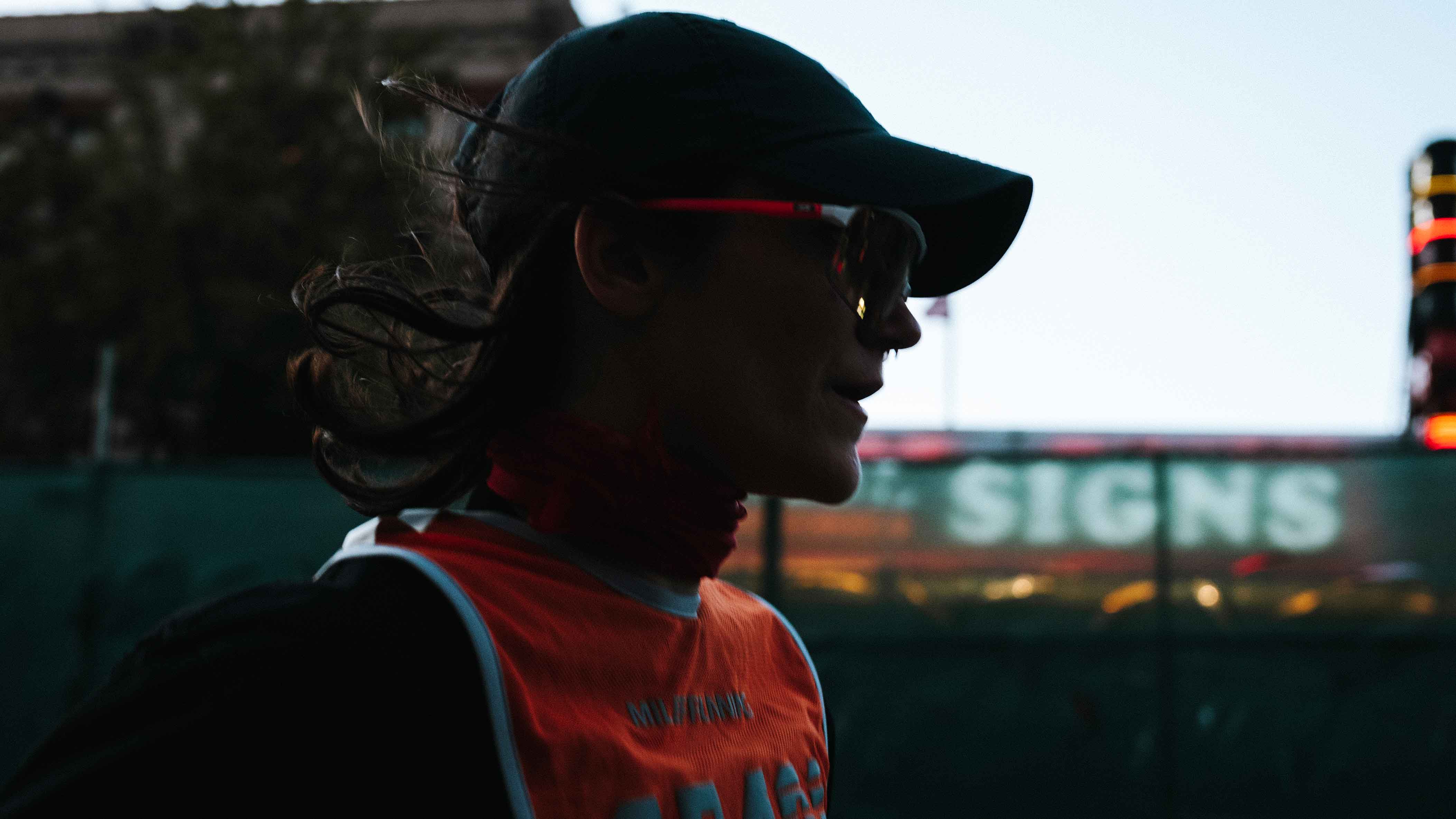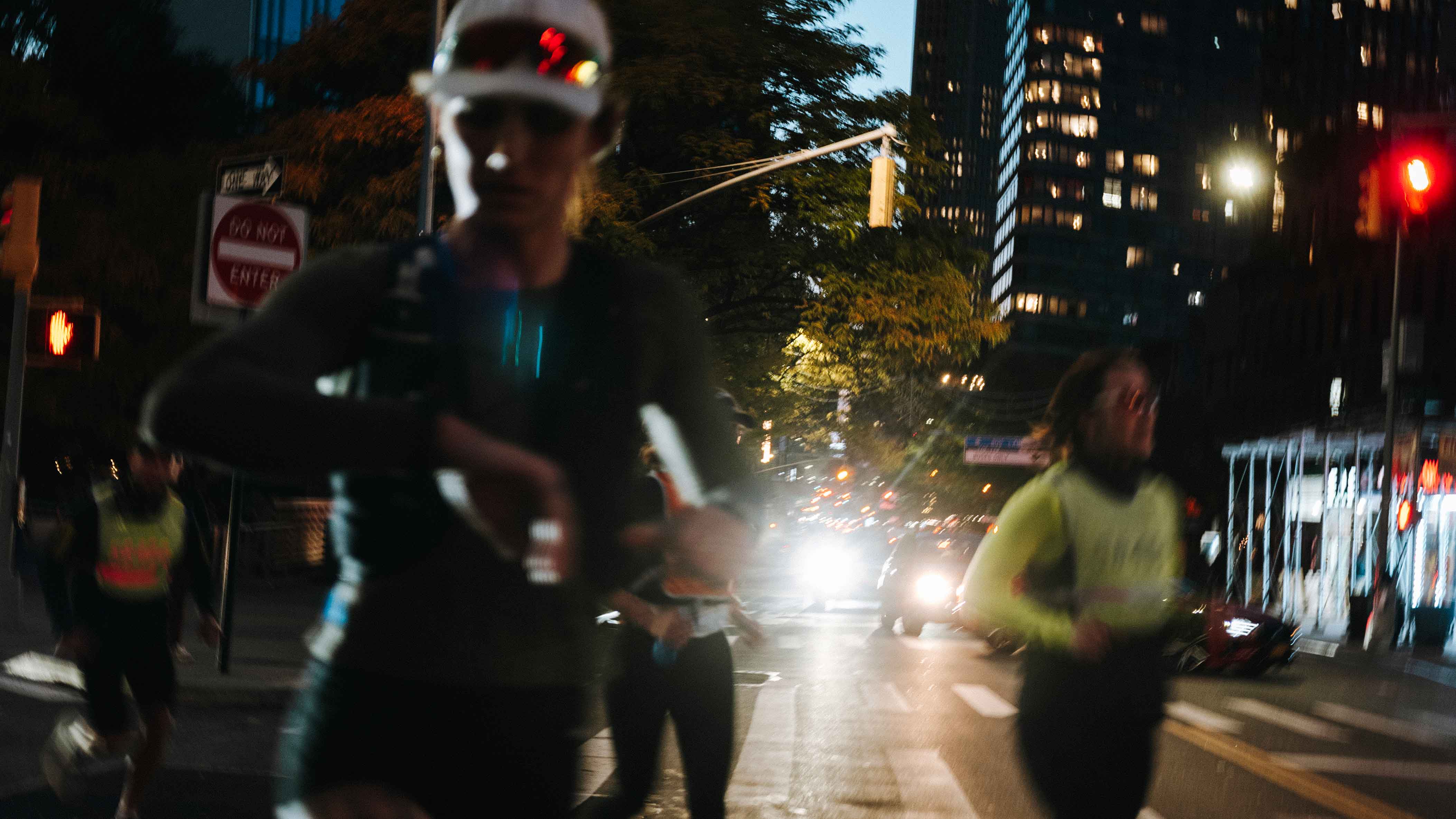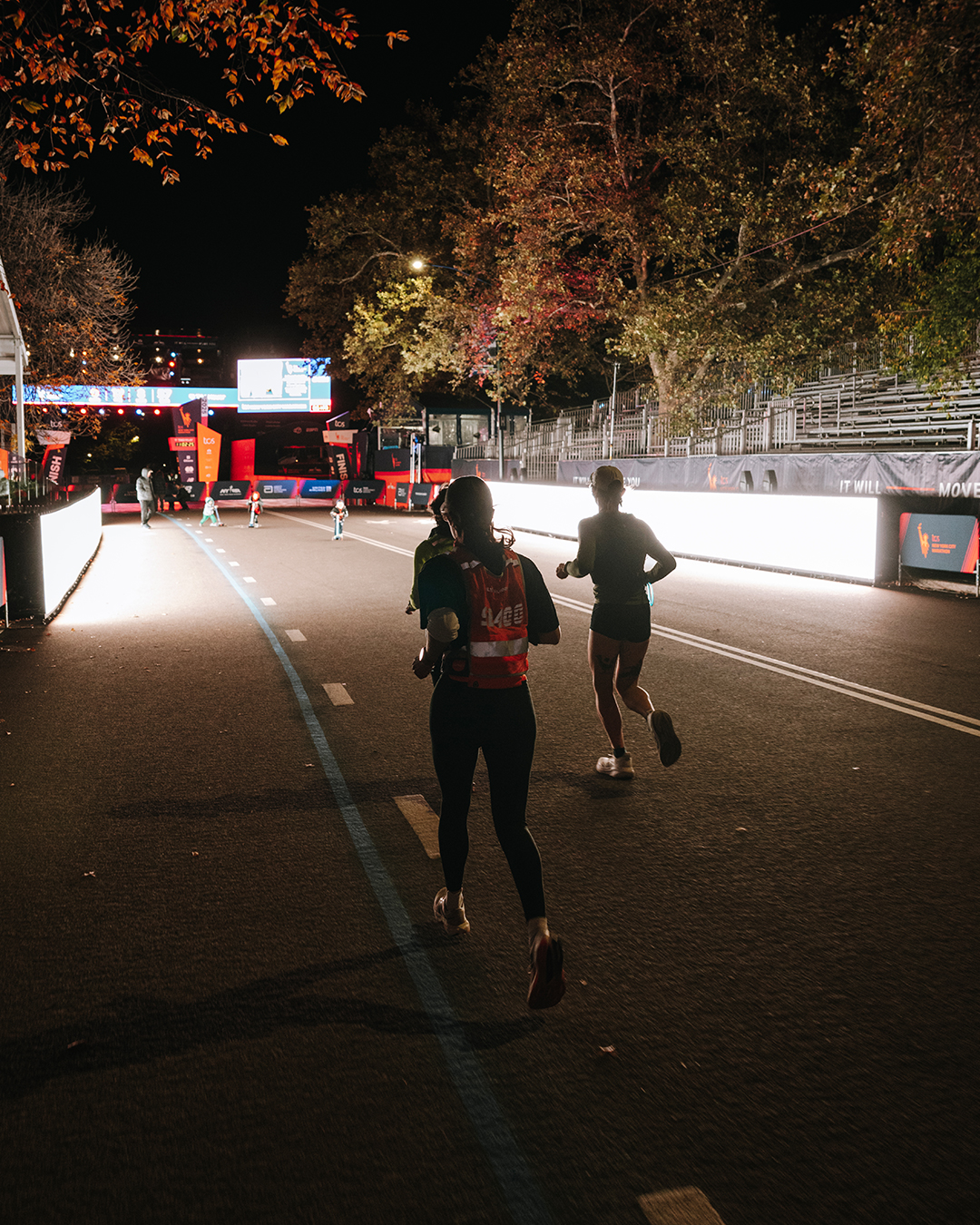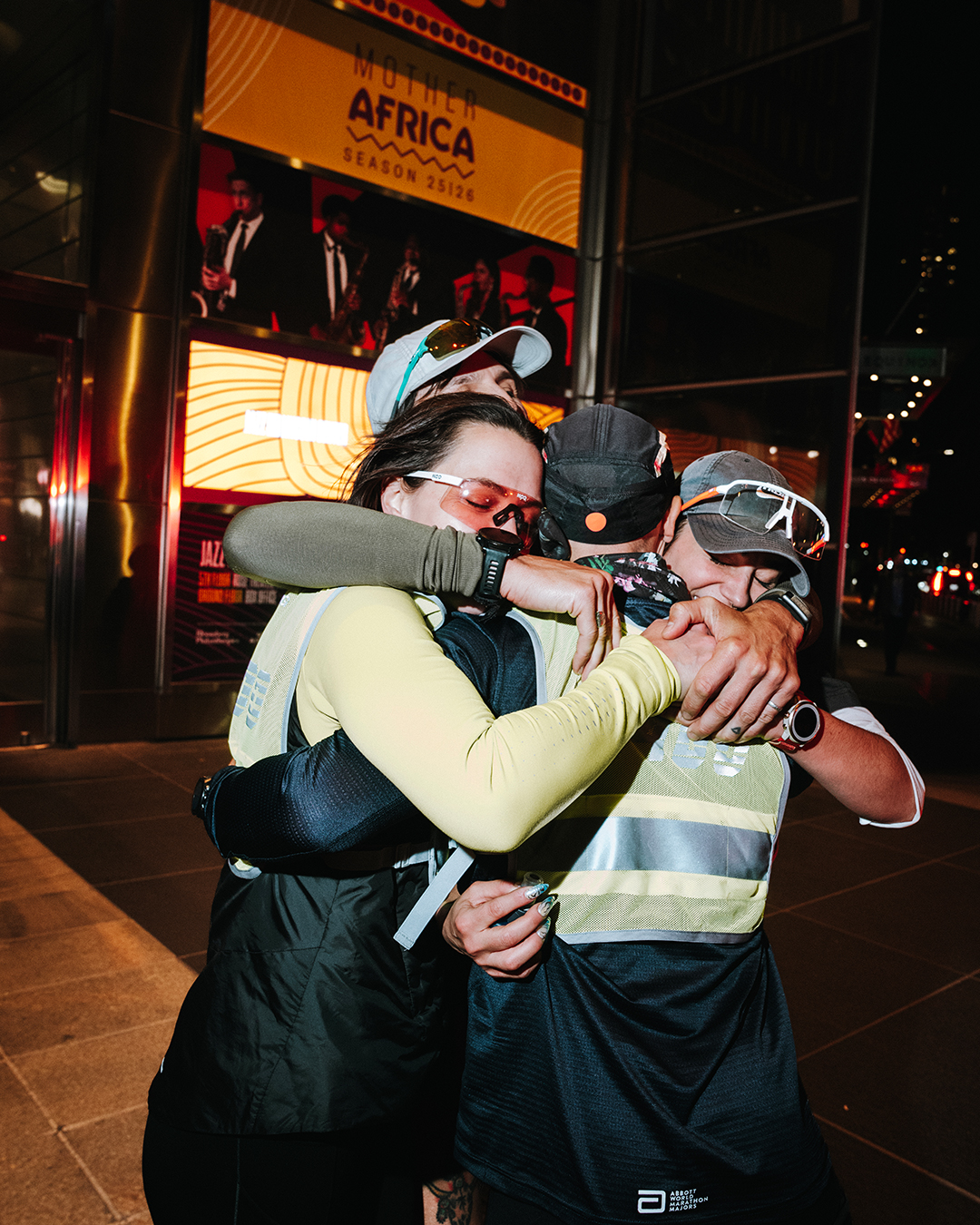November 20, 2025
Chasing Back to Back Marathon PBs in New York City
Words: Hannah Singleton
Photos: Dave Hashim
It wasn’t dusk yet when we gathered at the base of the Verrazzano Bridge in Brooklyn. The city was buzzing with late-day traffic, but a few marathon barricades were already in place and tow trucks came out in full force to clear the streets for the next morning. Five runners stood in a circle by a park, stretching, pulling on bright-orange vests for visibility, and checking watches, counting down to go time.

Camille, Park, Stephanie, Dennis, and Dave—all NYC-based runners—would be on foot, and Will, one of the founders of Southbound 400, on a bike, and his co-founder Aingeru drove the support van. Jancy—Camille’s best friend—and I rode along in the car, ready to hand off water and peach gummies, or whatever else was needed.
We were all there so that NYC-based ultrarunner Camille Breslin could chase her fastest marathon time, just hours before the official New York City Marathon. In August, she finished The Speed Project in France (all 300 miles of it) solo. This, compared to that, was short. But she wanted to run her longest and fastest efforts in the same year. Her friend Dave nudged her towards something wilder: “Everybody does the marathon. You've never really been somebody that plays by the rules,” he told her. “So why don't we just do our own marathon and run it the night before so you can PB on your own terms?”

They mapped an unsanctioned marathon that traced as much of the official NYC course as possible, adding mileage to make up for the closed start on Staten Island and the blocked finish near Central Park. Then, a month before, Camille got a bib for Sunday. “I'm more of an ultrarunner than a marathon runner at this point, so why don't we just put the icing on the cake and try to PR twice?” she says. Her goal was to beat her marathon time from 2018—3:54—on Saturday evening, then wake up and do it again, faster. “I want to blow the barn doors off and see how fast I can go,” she told me the week before the attempt.


Camille ran cross-country throughout high school, then quit for years. Her best friend drew her back in 2017. She remembers standing at the 25-mile mark of the NYC Marathon, watching Jancy cruise by. “She was smiling,” Camille says. “It blew my mind. How does anybody do this? It makes no sense that people can run this distance.” The next year, she signed up for the Brooklyn Half and within months, she was marathon training. “I remember training in Massachusetts for the first marathon and hitting distances and crying on the side of the road,” she says. “Like, holy shit. I ran 20 miles. I've never run 20 miles. I just did that by myself.” Like many runners, she progressively pushed the distance since then.

Running, for Camille, is a way to stay grounded. “It's like the way that people take a shower and brush their teeth and wake up and go to bed,” she says. “In order to calm my nervous system and to be a self-regulated, functioning person, I have to run. It brings a lot of peace and self-reflection and time for myself.” She mostly trains alone, so the social part of the sport didn’t matter much.


That started to shift in May when she volunteered to support Southbound 400, a 400-mile stage race that stretches from Canada to New York City, by driving the media car. “It was so much fun—people halfway out the windows with cameras, telling me to slow down, speed up, track the runner,” she says. What stuck with her was the community—the way the teams regrouped at checkpoints each night to eat dinner and collapse into tents only to wake up at sunrise and run again.
Now, that same crew was showing up for her. “I was ready to do this on my own,” she tells me before her attempt. “I didn't even realize that there were follow cars.”

Running a PB attempt in New York City is already a difficult task, with five bridges and a rolling course. Doing it the night before, on open roads, added another layer of complexity. As we moved through the city, it became obvious how much planning had gone into it.
At the start, Dave shared the map with the group and drew attention to two tricky intersections along the route where traffic would be heavy even after dark. During the run, Park and Stephanie set the tempo up front, and when the lights changed, Park jogged into traffic to hold off cars so Camille could keep moving. “I didn’t really think about logistics until it was happening,” she says. “But in the traffic, Park and Will were acting as human barricades. I was like, what the fuck—you guys are so badass.”

At first, the group was chatting and laughing as they worked their way through South Slope and into Fort Greene. But by the halfway mark—when we spotted their high-vis vests bouncing across the Queensboro Bridge at dusk—they had fallen into rhythm. Their breathing and footsteps seemed synchronized as they ran past the support van without breaking pace. Will pulled off for bottles and gels, which the team passed to Camille so she didn’t have to think about fueling. From the passenger seat, I watched them move like a single unit through the empty streets in Harlem, Camille looking steady and locked in.


When the group crossed the invisible finish line—an unmarked spot near Columbus Circle—her watch read 3:49:09. She collapsed into hugs from her pacers and friends. “It felt like a big win,” she says. “Even if Sunday didn’t go to plan, I’d still be happy. The amount of energy and care that went into that run—those are some good people.”

Saturday cracked something open for her about what running can look like—to be around other people and understand what support feels like. She was reminded of what her cross country coach taught her. Sure, running seems like an individual sport, but you win as a team. “How we support each other through the season and grow together is what it’s all about,” she remembers. “Creating that camaraderie and a collective mindset, I’ll never forget about that.”
The next morning, she lined up again at the start of the New York City Marathon; this time with 50,000 other runners by her side. Laser focused, she tuned out the spectators at the sidelines, settling in to find the same rhythm she’d felt the night before. She crossed the finish line at 3:39:57 and cried. Another PR.

“I can’t believe that just happened,” she says. “If I did this alone, it would’ve been one thing. But everybody had a role. That’s what’s cool about these weird projects—it’s never just one person. It’s always a team.”


Hannah Singleton is a freelance health and fitness journalist based in Brooklyn, NY. You can find more about her on her website.